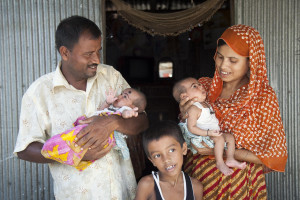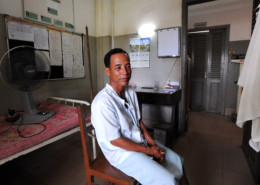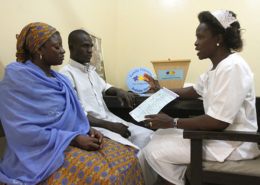
A family in Bangladesh. © 2011 Johns Hopkins University Global mHealth Initiative, Courtesy of Photoshare
Social and behavior change communication (SBCC) offers a unique opportunity to address gender-related attitudes, norms and behaviors, including among those who do not typically access health services, such as men and young people, as well as those that provide services, such as clinical providers and community health workers. SBCC also extends beyond health services into the community, workplaces and other institutions to provide tailored information, with the opportunity to address gender discrimination, gender-based violence and gender roles and encourage couple communication and community dialogue – all of which can lead to changes in health outcomes.
HC3 worked to support the achievement of gender equality and sustained health behavior change through three strategic approaches:
- Research and evaluation to examine how gender-related attitudes and norms influence specific health behaviors, per audience and context, as well as how and to what extent SBCC can influence these norms and behaviors;
- Implementation of SBCC interventions and approaches to create gender transformative shifts in social norms and individual attitudes and behaviors; and
- Strengthening capacity of SBCC practitioners and other partners in using SBCC for gender transformation and integrating gender into program design, implementation and evaluation.
Highlights of HC3’s work in gender transformation for research, implementation and capacity strengthening include:
- A secondary analysis examining the use of gender equity in health communication programs to increase contraceptive use. Two infographics, Gender Equity and Family Planning Outcomes and Gender Dynamics and Modern Contraceptive Use summarize the research methods and results of the study. HC3’s conclusions and recommendations are also available.
- A “Smart Couple” campaign in Nepal that uses a gender synchronized approach to encourage young couples in their first three years of marriage to use modern contraceptives. Using an aspirational approach, the campaign empowers young Nepali couples to envision a bright future.
- The Integrating Gender into Social and Behavior Change Communication Implementation Kit, which is designed to help SBCC professionals integrate gender into their SBCC programs. The I-Kit helps users understand gender concepts, theories and frameworks, assess the current level of gender integration in a project, and use a series of tools to uncover new information that can be applied to an existing SBCC strategy or marketing plan.
- The Guide for Promoting Sexual and Reproductive Health Products and Services for Men focuses on meaningfully engaging men and creating an enabling environment to increase men’s use of sexual and reproductive health (SRH) products and services. Drawing on lessons learned from the promotion of male condoms, vasectomy, voluntary medical male circumcision, HIV testing services and sexually transmitted infection testing and treatment, the guide provides guidance, resources and examples of approaches that have increased men’s use of SRH products and services in a variety of settings.








